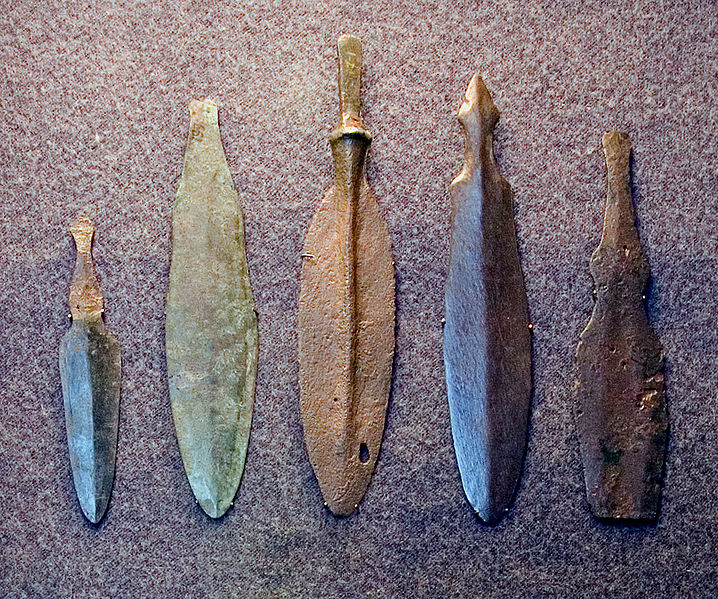It looks like you're using an Ad Blocker.
Please white-list or disable AboveTopSecret.com in your ad-blocking tool.
Thank you.
Some features of ATS will be disabled while you continue to use an ad-blocker.
5
share:
A team has discovered a culture using sophisticated gilding techniques on the Eurasian steppe grasslands of present-day Russia, dating from 1850-1700
B.C. at the beginning of the Late Bronze Age.
These people learned to
These were people associated with the Srubnaya/Srubna/Srubnik culture. They mined copper and produced metalwork regularly on a small scale even though they were not members of urban civilizations that are more commonly associated with such early technologies




Before these findings, this type of gilding method had only been found before in the Andes and in Mesopotamia
Original Article
These people learned to
covered pendants with a foil no more than one-tenth of a millimeter thick made of an alloy of gold and silver known as electrum. While the overall gold content of the foil is less than silver, through depletion gilding ancient Eurasian metallurgists were able to manipulate the concentration of gold on the outer surface to make the ornaments look like solid gold.
These were people associated with the Srubnaya/Srubna/Srubnik culture. They mined copper and produced metalwork regularly on a small scale even though they were not members of urban civilizations that are more commonly associated with such early technologies




Before these findings, this type of gilding method had only been found before in the Andes and in Mesopotamia
Original Article
reply to post by Hanslune
That's fascinating Hans,
I wonder how they obtained thier gold, I'd bet they traded horses for some . As far as I know the steppes aren't one of the best gold producing areas. There are certain geological conditions that need for gold to be found and the steppes don't meet them. But mountains that surround the plains would be a place to find gold.
I also wonder what they used as a corrosive agent, salt would have been almost as valuble as gold and most natural acids aren't strong enough, by themselves, maybe a combination of both with a little heat.
I work with tomato processing equipment and certain cooking processes will eat 304-316 ( the most corrosion resistant stainless steel) like they were plain iron in seawater.
What is also fascinating is the fact that the guilding protected the bronze object from further corrosion.
I think the term nomadic, is s misnomer, when though these people moved around, they were not nomads just
wandering aimlessly. Like modern herdsmen they likely made a seasonal circuit of pasture lands and other areas that provided what they needed.
That's fascinating Hans,
I wonder how they obtained thier gold, I'd bet they traded horses for some . As far as I know the steppes aren't one of the best gold producing areas. There are certain geological conditions that need for gold to be found and the steppes don't meet them. But mountains that surround the plains would be a place to find gold.
I also wonder what they used as a corrosive agent, salt would have been almost as valuble as gold and most natural acids aren't strong enough, by themselves, maybe a combination of both with a little heat.
I work with tomato processing equipment and certain cooking processes will eat 304-316 ( the most corrosion resistant stainless steel) like they were plain iron in seawater.
What is also fascinating is the fact that the guilding protected the bronze object from further corrosion.
I think the term nomadic, is s misnomer, when though these people moved around, they were not nomads just
wandering aimlessly. Like modern herdsmen they likely made a seasonal circuit of pasture lands and other areas that provided what they needed.
This is VERY interesting. A very intricate process for such a relatively primitive people. This is the kind of thing that brings Maslow into
question
reply to post by bigfatfurrytexan
Well if you mean self-actualization other 'primitive' cultures do things that are creative, story telling, making up religions, craftsmanship in less survivalable materials...or you can just move these Srubna up a notch or two.
When you find such creative solutions in a culture one is reminded of Edison or one of the other greats, at some point a very bright person was born into that culture and figured out how to do x and y to get the result that has come down to us.
In a way it is a reflection of something observed in mankind since we became human, the desire to create and if you want to be mean spirited, to cheat. I suspect this craftsman didn't tell his customers the gold object they had was only 'coated'!
Well if you mean self-actualization other 'primitive' cultures do things that are creative, story telling, making up religions, craftsmanship in less survivalable materials...or you can just move these Srubna up a notch or two.
When you find such creative solutions in a culture one is reminded of Edison or one of the other greats, at some point a very bright person was born into that culture and figured out how to do x and y to get the result that has come down to us.
In a way it is a reflection of something observed in mankind since we became human, the desire to create and if you want to be mean spirited, to cheat. I suspect this craftsman didn't tell his customers the gold object they had was only 'coated'!
reply to post by Hanslune
It is the application of chemical processes that is most amazing. That is a sublime sort of knowledge. Yes, Roman arches are incredible, but they are also more concrete. Gilding is a more abstract skill.
This morning i watched a show on Discovery about indigenous peoples building tree houses. It was amazing how they just pulled raw materials together, ad hoc and in situ, and cobbled together a rather nice, luxurious house that was a hundred or more feet up in a tree top.
Watching them make rope from vines was interesting, but I had seen that sort of thing before. What really wowed me was when the stripped bark from trees, rolled it up, then unrolled it for a sort of carpeting. And their roofing method was highly meticulous. Had they had regular three tab shingles, they could have put them on using the exact same methodology.
WHen their house was done, they all sat back and just took in the sight of the canopy. They all agreed that they lived in paradise.
It is the application of chemical processes that is most amazing. That is a sublime sort of knowledge. Yes, Roman arches are incredible, but they are also more concrete. Gilding is a more abstract skill.
This morning i watched a show on Discovery about indigenous peoples building tree houses. It was amazing how they just pulled raw materials together, ad hoc and in situ, and cobbled together a rather nice, luxurious house that was a hundred or more feet up in a tree top.
Watching them make rope from vines was interesting, but I had seen that sort of thing before. What really wowed me was when the stripped bark from trees, rolled it up, then unrolled it for a sort of carpeting. And their roofing method was highly meticulous. Had they had regular three tab shingles, they could have put them on using the exact same methodology.
WHen their house was done, they all sat back and just took in the sight of the canopy. They all agreed that they lived in paradise.
edit on
14-7-2012 by bigfatfurrytexan because: (no reason given)
Originally posted by bigfatfurrytexan
reply to post by Hanslune
It is the application of chemical processes that is most amazing. That is a sublime sort of knowledge. Yes, Roman arches are incredible, but they are also more concrete. Gilding is a more abstract skill.
This morning i watched a show on Discovery about indigenous peoples building tree houses. It was amazing how they just pulled raw materials together, ad hoc and in situ, and cobbled together a rather nice, luxurious house that was a hundred or more feet up in a tree top.
Watching them make rope from vines was interesting, but I had seen that sort of thing before. What really wowed me was when the stripped bark from trees, rolled it up, then unrolled it for a sort of carpeting. And their roofing method was highly meticulous. Had they had regular three tab shingles, they could have put them on using the exact same methodology.
WHen their house was done, they all sat back and just took in the sight of the canopy. They all agreed that they lived in paradise.edit on 14-7-2012 by bigfatfurrytexan because: (no reason given)
I was always impressed with local abilities to make rope bridges and the Vanuatu making bungee jumps using vines.
new topics
-
Where should Trump hold his next rally
Politicians & People: 8 minutes ago -
Shocking Number of Voters are Open to Committing Election Fraud
US Political Madness: 52 minutes ago -
Gov Kristi Noem Shot and Killed "Less Than Worthless Dog" and a 'Smelly Goat
2024 Elections: 1 hours ago -
Falkville Robot-Man
Aliens and UFOs: 1 hours ago -
James O’Keefe: I have evidence that exposes the CIA, and it’s on camera.
Whistle Blowers and Leaked Documents: 2 hours ago -
Australian PM says the quiet part out loud - "free speech is a threat to democratic dicourse"...?!
New World Order: 3 hours ago -
Ireland VS Globalists
Social Issues and Civil Unrest: 3 hours ago -
Biden "Happy To Debate Trump"
2024 Elections: 4 hours ago -
RAAF airbase in Roswell, New Mexico is on fire
Aliens and UFOs: 4 hours ago -
What is the white pill?
Philosophy and Metaphysics: 6 hours ago
top topics
-
A Warning to America: 25 Ways the US is Being Destroyed
New World Order: 14 hours ago, 21 flags -
Blast from the past: ATS Review Podcast, 2006: With All Three Amigos
Member PODcasts: 6 hours ago, 11 flags -
Mike Pinder The Moody Blues R.I.P.
Music: 6 hours ago, 8 flags -
Biden "Happy To Debate Trump"
2024 Elections: 4 hours ago, 8 flags -
James O’Keefe: I have evidence that exposes the CIA, and it’s on camera.
Whistle Blowers and Leaked Documents: 2 hours ago, 5 flags -
What is the white pill?
Philosophy and Metaphysics: 6 hours ago, 5 flags -
Australian PM says the quiet part out loud - "free speech is a threat to democratic dicourse"...?!
New World Order: 3 hours ago, 5 flags -
Ireland VS Globalists
Social Issues and Civil Unrest: 3 hours ago, 4 flags -
RAAF airbase in Roswell, New Mexico is on fire
Aliens and UFOs: 4 hours ago, 4 flags -
Putin, Russia and the Great Architects of the Universe
ATS Skunk Works: 9 hours ago, 3 flags
5
